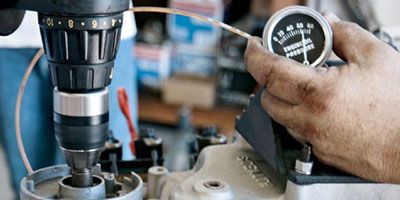
If you haven't heard the jungle drums rumbling, the life of your flat-tappet hydraulic camshaft may be in danger. But with a few careful steps and some attention to detail, you can avoid the killer of innocent camshafts FLCS-flat lobe cam syndrome. Just follow our lead.
Over the past couple of years, the Detroit Big Three have been lobbying to lower the levels of the antiwear agent zinc in motor oils. It seems that after engines get a few miles on them, it's not uncommon for some oil to be burned in the combustion process. The zinc dialkyl dithiophosphate (ZDDP) additive creates an ash when burned that is apparently very good at coating oxygen sensors and the active substrate in catalytic converters, reducing their performance. Since virtually every late-model production engine uses roller tappets, the American Petroleum Institute (API) has lowered the ZDDP levels in motor oils listed as meeting the current SM oil rating.
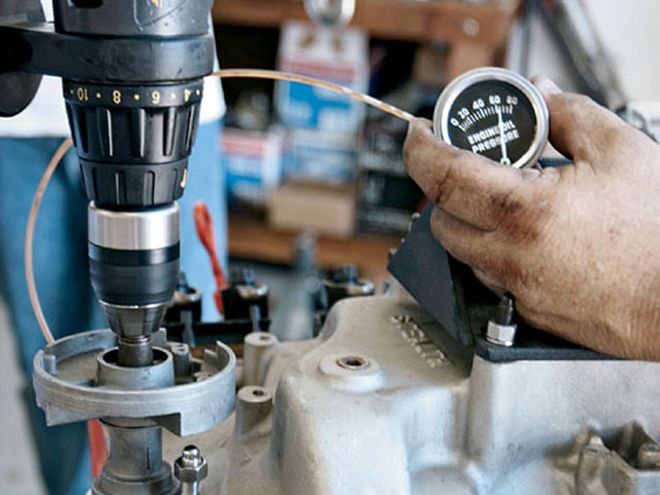 Pressure-lubing an engine before initial startup with a new flat-tappet cam is absolutely necessary now to prevent flattening a cam lobe or two.
Pressure-lubing an engine before initial startup with a new flat-tappet cam is absolutely necessary now to prevent flattening a cam lobe or two.
Why is this important to a typical car crafter with a flat-tappet camshaft and no catalytic converters? This same zinc additive is a wonderful antiwear additive for sliding-follower, flat-tappet camshafts. Before you panic, the zinc has not been removed, but the levels are far lower than with older oil configurations. As a result, aftermarket cam companies are seeing an increasing number of flat-lobe problems.
If there is one period of time when a flat-tappet hydraulic or mechanical lifter cam is most susceptible to severe wear, it is during the first 20 to 30 minutes of camshaft operation. This is when the lifter and cam lobe create their initial wear pattern. If sufficient high-pressure lubricants (like zinc and phosphorous) are present during this break-in procedure, the camshaft has an excellent chance of survival. We'll go over the details of how to properly break in a flat-tappet cam and which oil to use to ensure the cam doesn't fail a few thousand miles down the road.
Break-In Procedures
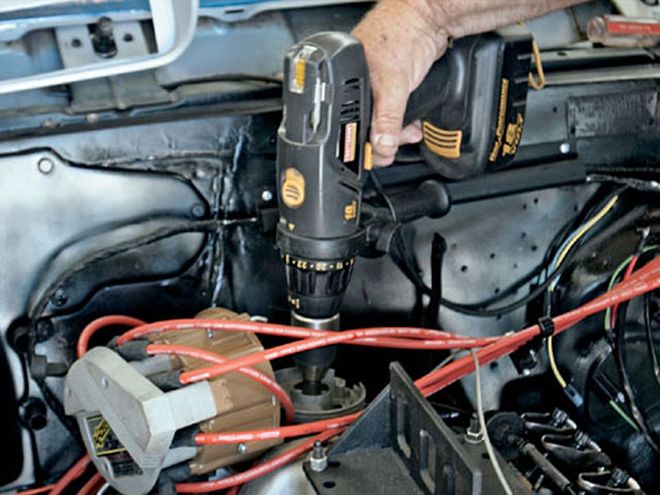 With the dummy oil-pump drive in the distributor hole, use an electric drill motor to spin the oil pump to create oil pressure. Remember to spin the oil pump in the correct rotation. Chevys spin clockwise while Fords spin counterclockwise.
With the dummy oil-pump drive in the distributor hole, use an electric drill motor to spin the oil pump to create oil pressure. Remember to spin the oil pump in the correct rotation. Chevys spin clockwise while Fords spin counterclockwise.
Let's assume you've just finished bolting that killer new engine in your car. Before you hit the starter motor and shake the pavement with all that horsepower, there are a couple of crucial camshaft break-in procedures you should follow. Your first step should be to remove the distributor so you can prelube the engine. Prelubing uses an old distributor or a specialty tool to independently spin the oil pump.
We built an oil-pump primer out of an old point distributor for our small-block Chevy by removing the cam drive gear and cutting off the top of the distributor-shaft weight pivot. We then had a friend machine the top of the shaft so we could use either a 11/44- or 11/42-inch drill motor. A corded 11/42-inch drill motor has the most torque. We retained the distributor body, since it directs oil to both sides of the lifter galley. Without the distributor body, only one side is lubed. Engage the oil-pump driveshaft and spin the drill motor. It's also a good idea to rotate the engine by hand a quarter turn at a time to ensure all the lifters get oil. This process should only take about five minutes but can sometimes take longer. A big-block Chevy will take much longer to pump oil to all the rocker arms-perhaps as long as 20 minutes.
Now replace the distributor by positioning the engine at No. 1 cylinder at roughly 16 degrees before top dead center (BTDC) on the harmonic balancer. Line up the distributor rotor with the No. 1 spark-plug wire on the distributor cap and cinch the distributor down. This will ensure you have around 16 degrees of initial timing in the engine when you first hit the starter. Prime the carburetor by pouring some fuel into the primary fuel bowl through the vent tube. Work the accelerator linkage until you have fuel squirting into the manifold. Assuming you have also filled the engine with oil and the cooling system with water, you're ready to fire the engine. The reason for all this preparation is to minimize the amount of cranking necessary to start the engine. With everything set correctly, the engine will fire on the first or second revolution.
Once the engine fires, immediately bring the rpm up to between 2,000 and 3,000. All camshafts in V-8 engines are splash-lubricated from oil whipped up by the crankshaft. Spinning the engine at these higher speeds for the first 20 minutes ensures sufficient oil reaches the cam lobes. We prefer to have the full exhaust connected so we can hear the engine while it's running to listen for any misfire or engine problems. This is a good time to double-check the ignition timing. Also, make sure engine rpm never remains constant for the break-in period. Engine speed should vary between 2,000 and 3,000 the entire time. This ensures oil reaches all points on the camshaft. Do not merely set the fast idle on the choke and walk away from the engine. Also, use this break-in time to watch for leaks or other problem areas and to monitor the coolant level and temperature. We like to use tap water for this first break-in period so it can be easily drained if there is a problem
Why Break-In's Not a Crime
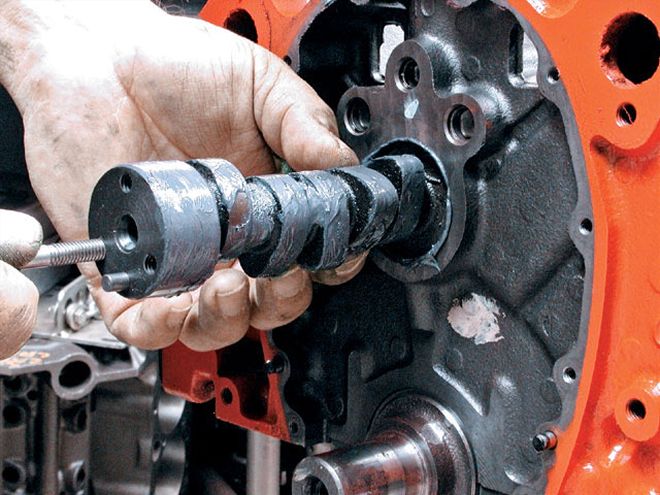 A few years ago, the cam companies stopped selling cams with molybdenum disulfide as a lobe lubricant, instead relying on a thicker assembly lube without moly. This is because that black moly paste is highly abrasive and can damage other delicate engine components. Do not substitute white paste, like Lubriplate, however, since this is not a high-pressure lubricant.
A few years ago, the cam companies stopped selling cams with molybdenum disulfide as a lobe lubricant, instead relying on a thicker assembly lube without moly. This is because that black moly paste is highly abrasive and can damage other delicate engine components. Do not substitute white paste, like Lubriplate, however, since this is not a high-pressure lubricant.
If your engine is equipped with a roller cam, this story really doesn't relate. But because a flat-tappet-style camshaft relies on a follower that slides across the cam lobe, it requires lubrication that can minimize this sliding type of wear. All off-the-shelf oils that have a current API SM rating have had the zinc levels reduced to protect catalytic converters. This is not to say that using the current SM-spec oil will eventually kill your flat-tappet camshaft. There are probably thousands of engines running around right now without difficulty.
There are some mechanical things that could predispose particular engines to wear problems. Excessive valvespring pressure will only aggravate these problems, since these higher spring rates create more load between the lifter and cam lobe. Crane Cams suggests flat-tappet cams not exceed 300 pounds of load over the nose of the lobe. Generally, most street hydraulic cams do not see this much load at max lift, since the open-spring pressure is divided by the rocker ratio. So, if the open-spring pressure is 400 pounds and the rocker ratio is 1.5:1, the load on the lifter is around 266 pounds.
Flat-tappet lifters are designed to spin in the lifter bores. This requires that the lifter bores be free of burrs or casting flash that can cause the lifter to stick and not rotate. Big-block Chevys are infamous for sticking lifters because of their angled pushrods. If you think there is a problem, place a color stripe on the pushrod and watch it with the valve cover removed as the engine runs. If the pushrod does not rotate, the lifter is not spinning.
High-ratio rocker arms also tend to place more load on the lifter and cam lobe. This is because higher rocker ratios open the valve farther, which increases the load between the lifter face and the cam lobe at every point on the lobe. For break-in purposes, you should break the cam in with a shorter-ratio rocker arm and then swap the rockers after the first hour or so of engine operation.
Post-Lube Moves
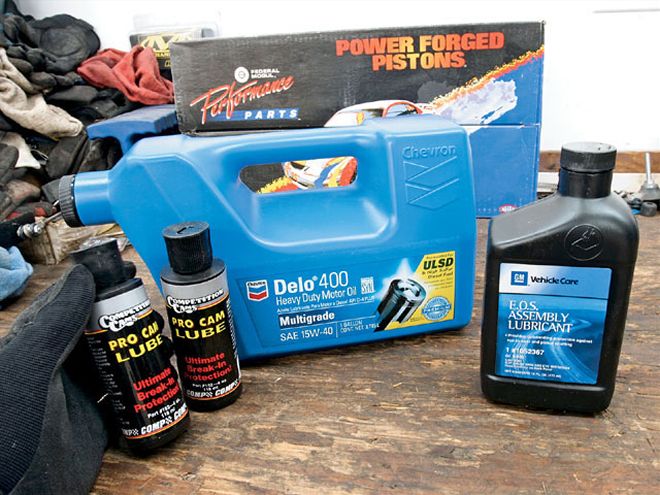 There are several different types of engine oils, including several diesel oils, that contain higher levels of zinc and offer better protection for flat-tappet lifters and cam lobes. The choice will come down to price and performance, with the diesel and racing oils being the best choice in terms of cost versus performance.
There are several different types of engine oils, including several diesel oils, that contain higher levels of zinc and offer better protection for flat-tappet lifters and cam lobes. The choice will come down to price and performance, with the diesel and racing oils being the best choice in terms of cost versus performance.
OK, you've followed all the rules and your camshaft is now broken in and makes lots of power and all is right with the world. But your job isn't over yet. First, put about 50 miles on the engine and then drain the oil and swap filters. This will get rid of the majority of the metal that ended up in the oil during break-in. If you really want to protect your flat-tappet-cammed engine, that standard API SM spec oil is not going to do the job as well as it should, since it lacks that double shot of antiwear zinc phosphate (ZDDP). While some overzealous enthusiasts are dumping a can of GM EOS in with every oil change, there is a better solution.
You may have heard several of the higher-quality diesel engine oils contain higher levels of zinc phosphate. We've listed several different brands that should be easy to find at your local auto parts store because of the increasing popularity of diesels pickups. Among these are racing oils such as Quaker State's Q Racing that offers higher levels of ZDDP as well as many other high-performance additives. If you have a question about an oil, look for an API SJ or SM rating. If the oil has either of these ratings, it probably does not offer higher levels of ZDDP. Racing oil is generally not API rated, since the oil is not intended for daily use in production engines. But for high-performance street engines, racing oils offer advantages as long as you treat the engine to frequent drain intervals.
Engine Oils Containing Higher Levels of Zinc Phosphate
BRAND WEIGHT Castrol Tection Extra 15W-40 Chevron Delo 400 15W-40 Mobil Delvac 1300 15W-40 Shell Rotella T 15W-40 Quaker State Q Racing 0W-5, 15W-50, and 17.5W-35 Joe Gibbs Racing MicroZol 0W-20, 10W-30
Zinc Levels in Motor Oil
The following levels give you an idea of how zinc concentrations have changed over the past three years. The new for 2007 CJ-4 diesel designation will reduce zinc levels even further.
YEAR OIL DESIGNATION (API) ZINC CONCENTRATION (parts per million-ppm) 1996 SH 1,300 2001 SJ 1,100 2005 SM 870 2006 Shell Rotella-T (diesel) 1,400 2006 Q Racing 1,960 2006 Joe Gibbs Racing XP-4 2,800
Parts List
DESCRIPTION PN SOURCE PRICE GM EOS, 16 oz. 1052367 Scoggin-Dickey $4.95 GM oil additive, 4 oz. 12345501 Scoggin-Dickey 7.39 Comp, Pro Cam Lube, 4 oz. 152 Summit Racing 6.99 Comp, Break-in Lube, 12 oz. 159 Summit Racing 15.39 Crane Super Lube, 8 oz. 99003-1 Summit Racing 8.50 Q-Racing 17.5W-35, 1 qt. --- Internet 13.30 Shell Rotella-T, 1 qt. --- Amazon.com 2.89